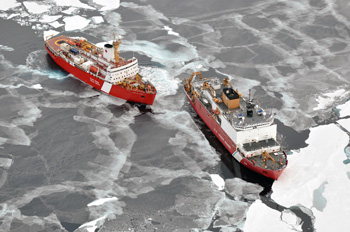Melting sea ice in the Arctic may be bad for polar bears, but it could prove a boon for seafarers. Recently, ship traffic in the region has begun to swell, with projections showing greater growth in coming decades.
“Although it’s still a small number of ships, there are still considerable risks to sailing in Arctic waters,” said Capt. John Mauger, chief of the Coast Guard’s Office of Design and Engineering Standards. Those risks include the region’s remoteness from rescue resources, ever-changing weather coupled with a paucity of weather sensors, ice floes that can ensnare vessels, and aging charts, some of which date back to the 1800s.
In response, the International Maritime Organization (IMO) has been working on a Polar Code to establish safety and environmental protocols for ships traversing the frigid waters around the two poles. The code is moving through the approval process and is expected to be finalized by year’s end.
Seafarers have long wished to shortcut through the Arctic. Now, with ice levels at historic lows, that dream is slowly becoming a reality. The number of ships traversing the Northern Sea Route along Russia’s northern coast — a voyage 40 percent shorter than the more traditional route via the Suez Canal — jumped from just four in 2010 to 71 last year. The greatest growth in Arctic traffic, however, has come from more localized traffic, such as ships transporting goods to and from offshore mining and oil and gas sites, or those originating in Murmansk, Russia, a key Arctic port.
The Polar Code categorizes ships based on their ability to travel through ice-choked waters — categories A, B and C. Although ships in Category C, the lowest bracket, aren’t ice-strengthened, they will still be allowed to travel through less icy polar waters at specific times of the year.
Ship operators will be required to carry a Polar Ship Certificate and develop a Polar Water Operational Manual. The details are still being sorted out, but Mauger said the manual would have to address evacuation procedures and equipment operation and maintenance in these bitterly cold regions. All crewmembers also would have to undergo special training.
“We would like to see the actual training requirements be carefully considered for what the roles of the individuals on the ships are,” said Bud Darr, senior vice president for technical and regulatory affairs at the Cruise Lines International Association in Washington, D.C. “A chef does not need the same level of training as a watchstanding officer on the bridge.”
Environmentalists contend that the Polar Code is not stringent enough. Critically, they would like to see a ban on heavy fuel oils, or HFOs. A pre-existing agreement bans HFOs in the Antarctic.
“The biggest threat to the environment would be an HFO spill,” said Kevin Harun, Arctic program director for Pacific Environment, an advocacy group based in San Francisco. Banning HFOs, however, would require switching to more expensive distillates, which has made it hard for the measure to gain traction.
Harun and others worry that the restrictions on Category C ships will be too lax. He cited a ship transporting diesel fuel that hit an iceberg last year. Although the accident was quickly contained, Harun sees it as a warning.
“Whether that ship would have been considered a C, I don’t know,” he said, “but it shouldn’t have been operating close to ice.”

